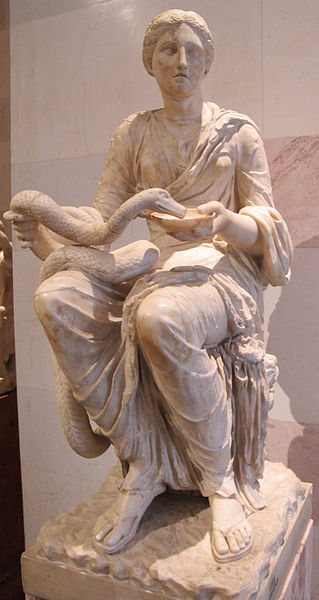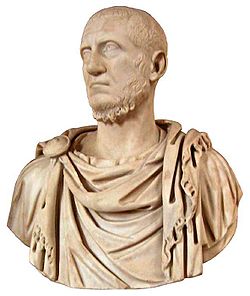|
Tacitus – Roman Emperor: 275-276 A.D. –
Bronze Antoninianus 22mm (3.74 grams) Rome mint: 275-276 A.D.
Reference: Estiot 0817, La Venera 1858; RIC 93 var (bust type for this reverse).
IMP CM CL TACITVS AVG, radiate head right.
SALVS AVG, Salus standing left, holding sceptre, feeding serpent rising
from altar.
Mintmark XXI delta.
You are bidding on the exact
item pictured, provided with a Certificate of Authenticity and Lifetime
Guarantee of Authenticity.
In
Greek
and
Roman mythology
, Hygieia (also Hygiea
or Hygeia, Greek Ὑγιεία or
Ὑγεία, Latin Hygēa or Hygīa),
was the daughter of the god of medicine,
Asclepius
, and
Epione
. She was the goddess/personification of
health, cleanliness and sanitation.

Hygieia
and her five sisters each performed a facet of
Apollo
‘s art: Hygieia (“Hygiene” the
goddess/personification of health, cleanliness, and sanitation),
Panacea
(the goddess of Universal remedy),
Iaso (the goddess of recuperation from illness),
Aceso
(the goddess of the healing process).
Hygieia also played an important part in her father’s
cult
. While her father was more directly
associated with healing, she was associated with the prevention of sickness and
the continuation of good health. Her name is the source of the word “hygiene“.
She was imported by the Romans as the Goddess Valetudo, the goddess of personal
health, but in time she started to be increasingly identified with the ancient
Italian goddess of social welfare,
Salus
.
History
At Athens, Hygieia was the subject of a local cult since at least the 7th
century BC. “Athena Hygieia” was one of the cult titles given to
Athenaa
, as Plutarch recounts of the building of
the Parthenon
(447-432 BC):
|
“ |
A strange accident happened in the course of building, which showed that
the goddess was not averse to the work, but was aiding and co-operating
to bring it to perfection. One of the artificers, the quickest and the
handiest workman among them all, with a slip of his foot fell down from
a great height, and lay in a miserable condition, the physicians having
no hope of his recovery. When Pericles was in distress about this, the
goddess [Athena] appeared to him at night in a dream, and ordered a
course of treatment, which he applied, and in a short time and with
great ease cured the man. And upon this occasion it was that he set up a
brass statue of Athena Hygieia, in the citadel near the altar, which
they say was there before. But it was
Phidias
who wrought the goddess’s image
in gold, and he has his name inscribed on the pedestal as the workman of
it. |
” |
However, the cult of Hygieia as an independent goddess did not begin to
spread out until the
Delphic oracle
recognized her, and after the
devastating
Plague of Athens
(430-427 BC) and in Rome in
293 BC.
In the 2nd century AD,
Pausanias
noted the statues both of Hygieia and
of Athena Hygieia near the entrance to the
Acropolis
of Athens.
Worship
Hygieia’s primary temples were in
Epidaurus
,
Corinth
,
Cos
and Pergamon
.
Pausanias
remarked that, at the Asclepieion
of Titane
in
Sicyon
(founded by
Alexanor
, Asclepius’ grandson), statues of
Hygieia were covered by women’s hair and pieces of
Babylonian
clothes. According to inscriptions,
the same sacrifices were offered at
Paros
.
Ariphron
, a Sicyonian artist from the 4th
century BC wrote a well-known
hymn celebrating her. Statues of Hygieia were created by
Scopas
,
Bryaxis
and
Timotheus
, among others, but there is no clear
description of what they looked like. She was often depicted as a young woman
feeding a large snake that was wrapped around her body or drinking from a jar
that she carried. These attributes were later adopted by the
Gallo-Roman
healing goddess,
Sirona
. Hygieia was accompanied by her brother,
Telesphorus
.
The
Pythagoreans
called the pentagram ὑγιεία Hugieia (“health”); also the Greek goddess of
health, Hygieia
and saw in the pentagram a mathematical perfection..
<>< p=””>
Salus (Health) a Goddess of the Romans, the same that was worshipped under
the name of Hygiea by the Greeks, who feigned her to be the daughter of
Asclepius and of Minerva. On a denarius of the Acilia family appears the head
of the goddess and on the reverse a female standing with a serpent in her hand.
The types of this divinity on imperial coins most frequently present to view a
woman clothed in the stola;  sometimes sometimes
she is sitting, at others standing; in others in a recumbent posture, with a
serpent either on her right or her left arm in a quiescent state, rising in
folds or entwined round an altar before her, and receiving food from a patera,
which she holds in her extended hand. It is in this form (which was doubtless
that of her statues and with these symbols) that she is exhibited on most coins
on the imperial series from Galba to Maximianus. She had a celebrated temple at
Rome, painted, it was said, by Q. Fabius, who thence was surnamed Pictor (the
painter) . – There appears to be some affinity between this personification of
Salus, when offering food in a patella to a serpent, and the Lanuvian virgin
represented in the same act on coins bearing the head of Juno Sospita. – The
opinion also has the probability on the face of it, which refers the serpent on
coins, where mention is made of Salus Augusti, or Augustorum, to Aesculapius and
his daughter Hygaeia (or Salus) as deities of Health. – Certain it is that when
those sanitary divinities, and especially when Dea Salus, occur on coins of
Emperors, they indicate that those princes were labouring at the time under some
diseases; on which account, it would seem, sacred rites had been performed for
them and the memorial of the event recorded on public monuments
Marcus Claudius Tacitus (ca. 200 – June 276) was a
Roman Emperor
from September 25 275, to June 276.
Biography
He was born in Interamna
(Terni), in
Italia
. He circulated copies of the historian
Gaius Cornelius Tacitus
‘ work, which was barely read at the time, and so we
perhaps have him to thank for the partial survival of Tacitus’ work; however,
modern historiography
rejects his claimed descent from the historian as forgery. In the course of his
long life he discharged the duties of various civil offices, including that of
consul
in 273,
with universal respect.
After the assassination of
Aurelian
,
he was chosen by the
Senate
to succeed him, and the choice was cordially ratified by the army. His first
action was to move against the barbarian tribes that had been gathered by
Aurelian for his Eastern campaign, and which had plundered the Eastern Roman
provinces after Aurelian had been murdered and the campaign cancelled. His
half-brother, the Praetorian Prefect
Florianus
,
and Tacitus himself won a victory against these tribes, among which
Heruli
, which
granted the emperor the title Gothicus Maximus.
Tacitus probably died of fever (according to
Aurelius Victor
,
Eutropius
and the
Historia Augusta
) – though
Zosimus
claims he was assassinated – at
Tyana
in
Cappadocia
in June 276.
<> |






 sometimes
sometimes



